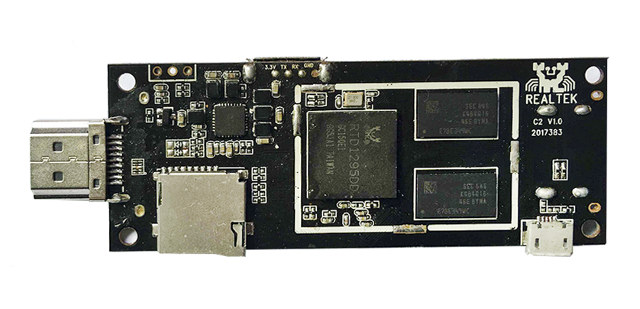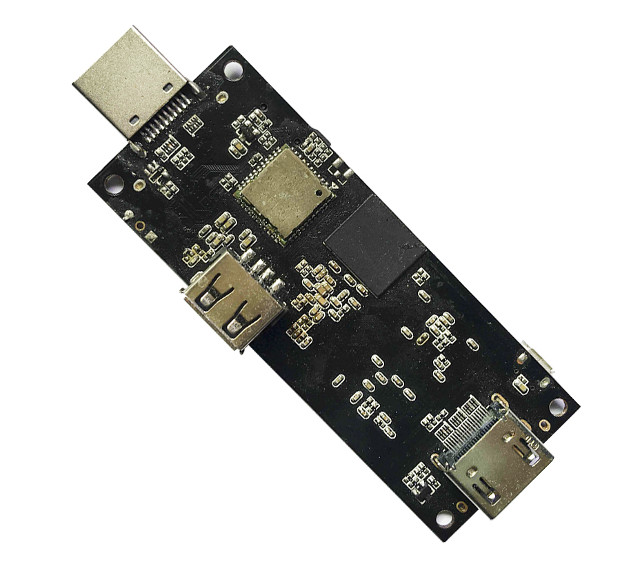Realtek RTD1295 processor is found in mid to high end 4K HDR TV boxes with interfaces like SATA, USB 3.0, as well as HDMI input used for PiP or video recording features. Devices equipped with the processor that come to mind include Zidoo X9S or EWEAT R9 Plus TV Box + NAS, both of which are full featured and fairly large devices, running Android 6.0 and OpenWrt.
Shenzhen Tomato has unveiled another type of device based on RTD1295 processor: X2 HDMI TV dongle that features both HDMI output & HDMI input ports, and runs Android 6.0 (but not OpenWrt).
- SoC – Realtek RTD1295 quad core Cortex A53 processor @ 1.40 GHz with ARM Mali-T820MP3 GPU
- System Memory – 1 or 2GB DDR4
- Storage – 8 or 16GB eMMC flash + micro SD slot
- Video & Audio I/O – HDMI 2.0a output, and HDMI 1.4 input
- Video Codec – 10-bit HEVC/H.265 up to 4K @ 60fps, H.264 up to 4K @ 24 fps, VP9 up to 4K @ 60 fps (30 fps in my experience)
- Connectivity – WiFi
- USB – 1x USB 2.0 port
- Misc – IR receiver, UART pins (3.3V/Tx/Rx/GND) on PCB
- Power Supply – 5V/2A via micro USB port
- Dimensions – TBD

Interestingly, the company was unable to provide exact dimensions, nor details about the supported WiFi module(s), but the confirmed HDMI input can be used for picture-in-picture (PiP), and recording video to USB mass storage. Network broadcasting may be supported too (TBC).
Shenzhen Tomato also mentioned they do not have a case for now, and could not provide sample / MOQ pricing information. Nevertheless, the company is still looking for OEM/ODM partners that may be interested in the solution, and you can get more details on the product page. We’ll probably find this TV dongle show up in various places once it starts selling at the retail level.

Jean-Luc started CNX Software in 2010 as a part-time endeavor, before quitting his job as a software engineering manager, and starting to write daily news, and reviews full time later in 2011.
Support CNX Software! Donate via cryptocurrencies, become a Patron on Patreon, or purchase goods on Amazon or Aliexpress






I don’t understand the reference to the poplar board article, as it states a Hisilicon v200 soc.
Or do the link point to the wrong article?
Thx
@Wolfgan
Sorry, memory bit flip 😉
@cnxsoft
So for RTD129x development boards we need to wait for U5PVR SBC or Banana Pi BPI-W2 board.
Some small misprint:”… both HDMI output & HDMI output ports ….” 🙂
@cnxsoft
The original link referring to an RTD129x dev board was why I was so excited when I read the original article, I immediately thought that I didn’t register the Poplar ref article in the past 🙂
I’l keep eagerly waiting for any very populated RTD129x dev board.
Thanks for keeping us informed!
@Wolfgan
Sadly Realtek doesn’t seem very interested in doing anything that doesn’t fit their ideas of what these SoC’s should be used for, so don’t hold your breath. I have tried to convince them for a while to do a project, but I keep being repeatedly told that they don’t have enough resources…
@Wolfgang – The Realtek 1296 reference design has quite a bit of connectivity, but, not all features are available in Linux.
https://lh3.googleusercontent.com/HWZXtKV0nqnuS4njAu7fD-MDNkklcEk_VwIa0exnOa1tQR17EkXs8HTbbMV7WnmWB-MEHd_8V6I58gTMNTCp=w1243-h509-rw
USB3, USB-C, 2x SATA, 2x mPCIe, HDMI in and out, 1x WAN, 2x LAN.
@miniNodes
The link return error 403 forbidden.
Anyway, I’d assume RTD1295 reference design may not be for sale to individuals.
Ooops, accidentally copy / pasted the raw source URL. Uploaded to self-hosted instead: https://www.mininodes.com/rtk1296.jpg
The reference design is interesting to then compare to how the board makers deviate or add / drop / alter configuration.
But yes, I doubt it would ever be sold as is.
🙂